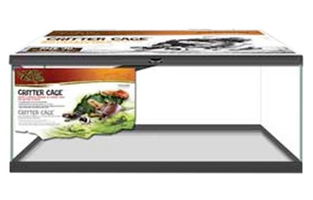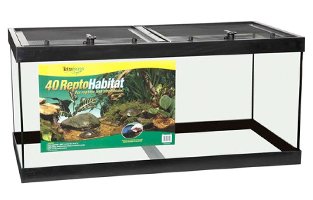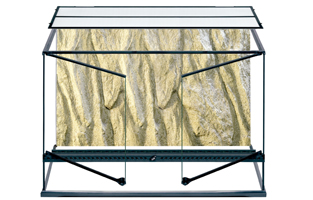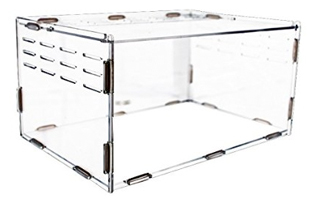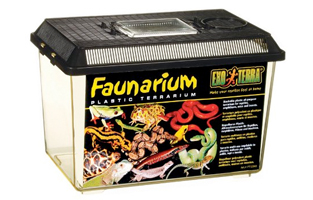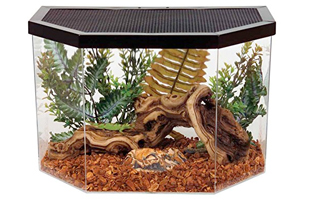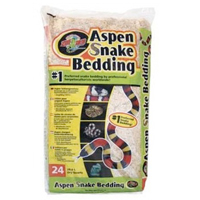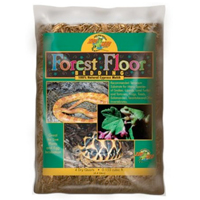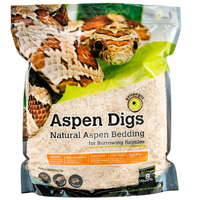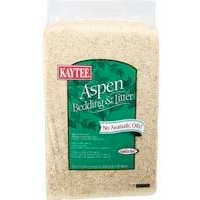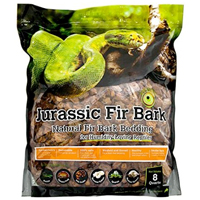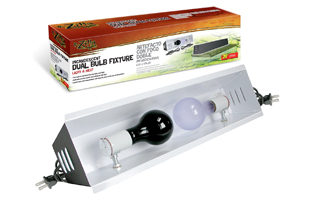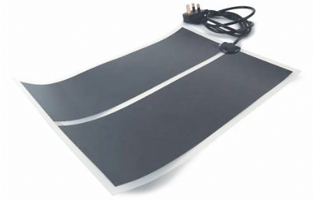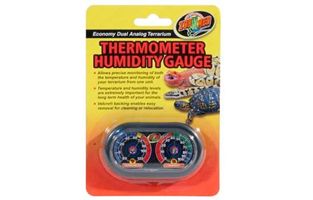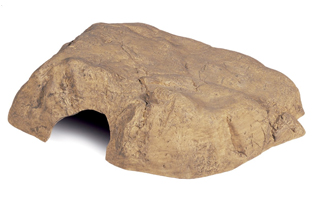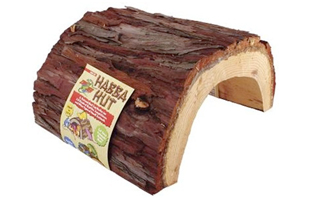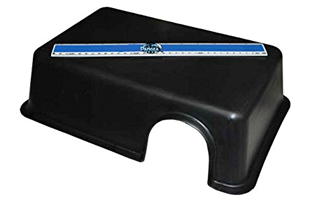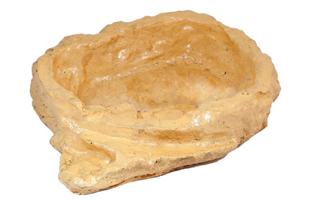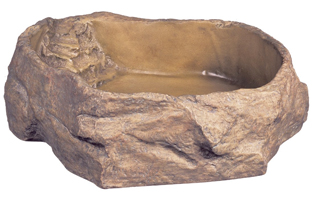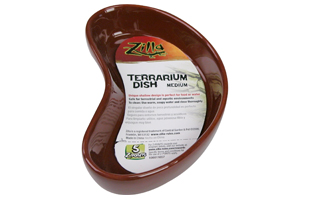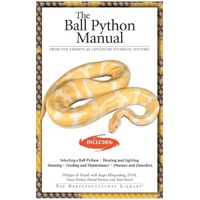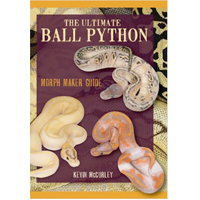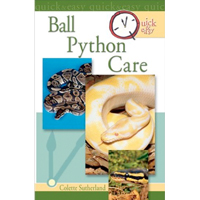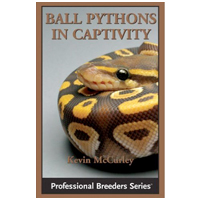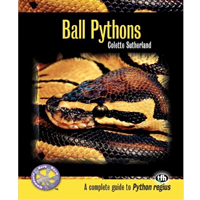You need 7 items to create a ball python vivarium: A glass or plastic terrarium, the proper flooring, a lighting / heat source, a thermostat & humidity gauge, a hide box, a water bowl and (of course) a live ball python.
How To Create A Ball Python Vivarium
A ball python (known by its Latin name, Python regius) is a non-venomous python snake species that is usually found in sub-Saharan Africa. Ball pythons are naturally found in the countries of Senegal, Mali, Guinea-Bissau, Guinea, Sierra Leone, Liberia, Ivory Coast, Ghana, Benin, Nigeria, Cameroon, Chad, the Central African Republic, Sudan and Uganda – but are now shipped and sold in countries all around the world as pets.

The ball python is the smallest of the African pythons and is one of the most popular python snake species in the entire world – due largely to the fact that this type of snake is docile and has a pleasant temperament, which makes them excellent as pets for both children and adults.
While this type of snake is most commonly known as the “ball python,” it is also known as the royal python in some parts of the world. The name “ball python” comes from snake’s tendency to curl up into a ball when stressed or frightened, whereas the he name “royal python” (from the Latin regius) comes from the fact that rulers of the past in Africa would occasionally wear the python as a type of ornate jewelry.
How Much Space Does A Ball Python Need?
At their absolute largest, adults ball pythons generally do not grow to more than 152–182 cm (5 – 6 feet). Males usually average around 90 107 cm (3 – 3.5 feet), while females tend to be slightly larger, growing to be, on average, about 122 – 137 cm (4 – 4.5 feet).
The build of your typical ball python is stocky, while the head is relatively small. The scales of a ball python are smooth and both sexes have anal spurs on either side of the vent. The ball python color pattern is typically black or dark brown with light brown or gold sides and dorsal blotches. The belly is a white or cream color and may include scattered black markings across its entire body.
It should be noted, however, that those in the pet industries have, through selective breeding, developed many ball python morphs (genetic mutations) with altered colors and patterns. Due to the rarity of these morphs, these snakes can sometimes sell for hundreds or thousands of dollars. There are hundreds of different ball python color patterns seen on snakes that are kept and raised in captivity. Some of the most common ball python morphs include: Spider, Pastel, Albino, Mojave and Lesser.
All single gene ball pythons can be bred together to make more complicated double gene pythons. For example, a Pastel python could be bred with a Black Pastel python, creating a Black Pewter ball python, which when bred will show both genes in its offspring. Breeders are continuously creating new designer morphs, and over 3,800 known morphs currently exist among ball pythons bred in captivity.
Ball pythons are popular as pets because of their small size (compared to other python species) and their docile temperament.
Ball python hatchlings should be kept in an enclosure with no more than 40 square inches of floor space. If a hatchling is placed in a container much larger than this, it may become insecure in its surroundings and refuse to feed – eventually dying.
As a ball python matures, however, you will need to increase the size of its cage. Pre-adult snakes will be happy with 120 to 200 square inches of floor space, while an adult ball python will require at least 400 to 600 square inches or more. A 20 gallon vivarium is usually suitable for most adult ball python snakes, but larger snakes will be more comfortable in a 30-40 gallon tank, as ball pythons are ground dwellers and are highly secretive and largely sedentary. Some large female ball pythons may require cages up to the 50 US gallons (190 L).
What Type of Cage Is Best For A Ball Python?
There are a wide variety of cage options available for ball pythons. Regardless of the type of enclosure used, it is important that every ball python vivarium be completely escape-proof. Ball python snakes are natural escape artists and can disappear from a cage very easily if given the opportunity. The cage must be easy to lock or safely secure. When a ball python learns even a single escape technique, you can be sure that it will try it again at some point in the future.
![]()
Glass tanks are the most common type of enclosure for a ball python – especially if you have just one or two snakes. This type of snake enclosure is available in most pet stores, at most reptile expos, and can also be easily purchased online and shipped to your home.
Many ball python owners enjoy the high-visibility aspect of glass and enjoy creating pleasing natural displays within their snake vivariums. Glass ball python tanks are also fairly inexpensive when compared with some of the other types of ball python cages, which need to be regularly cleaned and disinfected. A popular glass cage readily available in most pet and specialty stores is the Zilla 20 Gallon Critter Cage. This glass enclosure features a sliding screen top with an attachment that can accommodate a pin style lock or even a small padlock if necessary. These tops are a good choice when dealing with a pet snake in a household with small children – to prevent any accidental or unsupervised interaction.
While glass vivariums are ideal for keeping a ball python, you will discover that most glass snake tanks are equipped with a screen top or ceiling. Screen tops are specifically used with glass enclosures and provide excellent ventilation and airflow for your snake. However, these same characteristics can make it difficult to maintain the correct environment for your ball python. A screen top allows for the constant change of conditions between the snake’s environment and the room in which the vivarium is kept. This can mean necessary heat and humidity escaping from the ball python’s environment and potential sub-optimum temperatures and humidity within the tank.
![]() Luckily, the solution to this problem is simple: most snake owners simple eliminate this problem by placing a piece of Plexiglass over a portion of the top of their vivarium, which works to prevent heat and humidity loss from within.
Luckily, the solution to this problem is simple: most snake owners simple eliminate this problem by placing a piece of Plexiglass over a portion of the top of their vivarium, which works to prevent heat and humidity loss from within.
Another factor to keep in mind when using a glass tank or vivarium is the fact that ball pythons have a shy demeanor, and the high-visibility of a glass enclosure can be stressful and intimidating to a ball python, who prefers to hide, rather than be constantly exposed. This is why it’s a good idea to utilize one or more hide boxes within your glass enclosure to ensure that the ball python has the opportunity to hide if it feels threatened or shy. For larger ball pythons, be sure to provide a choice of hide locations within your vivarium – one in a heated warmer end and another in the cooler end.
Plastic herp caging has become a popular cage material among snake keepers for several reasons: It’s easy to heat, easy to disinfect, doesn’t warp under humid conditions, it’s mite-resistant, it’s lightweight, it’s inexpensive, and the cages are often stackable. Pre-made plastic enclosures come in a variety of shapes, sizes, colors and price ranges. And quite a few manufacturers offer custom add-ons, such as vents, built-in lighting, or heating. Since plastic ball python cages are made specifically for keeping reptiles, these cages tend to allow for more precise environmental control than glass or wooden enclosures – making them a fantastically easy way to store your ball python. As with any snake vivarium, plastic ball python cages should be escape-proof and even lockable – to keep small children out… and to keep snakes locked securely within.
![]() Finally, rack systems allow you to keep a large number of snakes in a small space. The concept of a rack system is that multiple levels of shelves containing a number of individual snake boxes are stacked on top of one another. Think of it as a large dresser filled with drawers meant for keeping snakes.
Finally, rack systems allow you to keep a large number of snakes in a small space. The concept of a rack system is that multiple levels of shelves containing a number of individual snake boxes are stacked on top of one another. Think of it as a large dresser filled with drawers meant for keeping snakes.
Reptile racks systems are available in a wide range of shapes, sizes and materials – the most common of which are plastic, metal and wood. Plastic storage boxes (such as those made by Rubbermaid and Sterilite) are sometimes used in these rack systems to house individual snakes, but most rack system manufacturers offer plastic boxes made specifically to fit their rack system.
Snake racks usually have some kind of heating element incorporated into their design – usually a strip of heat tape or a heat cable located at one side of the rack to provide a thermal gradient. Thermometers are also placed inside the containers of each individual snake, or at various points throughout each rack system drawer.
Certain rack systems feature and “open air” construction, similar to the screen top you might find on a glass aquarium, which can help to provide ventilation and accidental overheating. For rack systems utilizing a “closed construction” design, you need to make sure each individual snake enclosure is kept well-ventilated to ensure there is proper airflow for the health and safety of your snakes.
The majority of commercial snake breeders use Feeder Breeder rack systems to house and breed ball pythons. This rack system is an excellent way to manage a large number of snakes. This type of caging allows each snake to stay secretive and within the right temperature and humidity environment. This type of rack system also makes for an excellent rodent breeding environment, in which a large number of rodents can be bred and raised to adulthood.
Ball Python Flooring & Substrate
There are a number of different flooring substrates available for a ball python vivarium. Many pet stores sell terrarium carpet liners that can be easily washed and replaced when they become soiled, but the truth is, a ball python cage can be lined with anything from aspen or cypress mulch to paper towels. Do use any mulch or wood chippings that have a scent. Anything with a scent will be toxic to your snake and could kill it! For a more cost-effective means of lining the floor of your snake cage, just line your ball python vivarium floor with sheets of newspaper. As long as the flooring is not made up of shavings, the snake will fare just fine.
The primary concern with the flooring your of ball python vivarium is how easy it is to clean and how effective it is at keeping odors to a minimum. For the most part, the substrate only needs to be replaced about once every second or third month. However, routine maintenance must be done to clean out any uneaten food or stools. One of the easiest ways to keep your ball python vivarium clean is to feed your snake in a different contain that is kept a fair distance away from the habitat in which it is normally kept. Then, after your ball python has eaten, place him back in his normal vivarium.
Lighting, Heating & Humidity
Even though most ball python owners use heat lamps as the primary source of heat for their pets, they are not the only type of lighting that should be used. Instead, daylight or full-spectrum fluorescent lights are preferred since they promote better vitamin and mineral metabolism in reptiles. The ideal ball python vivarium will provide your snake with 12 hours of light and 12 hours of darkness. In the summertime, the daylight hours should be increased to 14 hours and then set back to 12 hours during the winter months to mimic the natural progression of the days.
The optimum temperature for a ball python vivarium is between 77 and 85 degrees Fahrenheit during the daytime. During the night, the temperature should be maintained between 69 and 75 degrees. Larger ball pythons should be equipped with a vivarium that has at least two different temperature zones – one area for basking where the temperature is increased to 90 degrees with an infrared heat lamp. For the protection of your ball python, all lighting should be kept outside of the cage – otherwise the snake can burn itself by getting too close to the heat source.
![]() While external lights are the most popular way to heat a ball python vivarium, you can also use other forms of heat to maintain the temperature through the night, including under-the-cage heating mats, overhead ceramic heaters or room-sized electric heaters. It is important that you never use heat rocks in a ball python vivarium because they can burn and even kill your snake.
While external lights are the most popular way to heat a ball python vivarium, you can also use other forms of heat to maintain the temperature through the night, including under-the-cage heating mats, overhead ceramic heaters or room-sized electric heaters. It is important that you never use heat rocks in a ball python vivarium because they can burn and even kill your snake.
Unlike some snakes, ball pythons don’t require a lot of humidity. Ideally, their habitat should have a humidity level of no more than 50 to 60 percent. If your snake is shedding its skin, increasing the humidity to 65 percent can help speed the process and this can be done by simply misting the habitat with water once a day. Be sure to regularly check the humidity in your ball python vivarium to ensure that your snake is happy and healthy.
Hide Boxes, Plants & Branches
Ball pythons are mostly nocturnal, so they need a comfortable place to sleep during the daylight hours. This can be anything from a simple cardboard box or an upside-down Terra-cotta planter with an opening on its side. However, commercially-made hide boxes are available at most pet stores and are highly-recommended. The only consideration for your snake hide is that the box be large enough to fit your snake’s entire body, but not so big that the snake doesn’t feel comfortable entering it. Also be wary of any sharp or pointy edges which might brush up against or puncture the skin of your snake.
![]() Ball pythons are not big climbers, but climbing tree branches does provide your snake with a valuable source of exercise. Therefore, large branches with with artificial greenery are great additions to any ball python vivarium, as these branches will provide your snake with both a place to exercise and some additional hiding places for the emotional well-being of your snake security. If you have larger tank for your snake, you might want to also add a few rocks of various sizes for your snake to crawl over or bask on.
Ball pythons are not big climbers, but climbing tree branches does provide your snake with a valuable source of exercise. Therefore, large branches with with artificial greenery are great additions to any ball python vivarium, as these branches will provide your snake with both a place to exercise and some additional hiding places for the emotional well-being of your snake security. If you have larger tank for your snake, you might want to also add a few rocks of various sizes for your snake to crawl over or bask on.
What Does a Ball Python Eat & Drink?
In the wild, the typical ball python diet consists of small mammals, such as African soft-furred rats, shrews and striped mice. Younger individuals have also been known to feed on birds. Pythons imported from the wild tend to be picky eaters and may not respond to food as well as captive-bred pythons, which usually do well on domestic rats and mice.

Live feeding a snake can be dangerous for the snake involved and should never be attempted by inexperienced keepers. The size of the prey item given to a python should be equivalent to or slightly larger than the width of the largest part of its body. The ball python is known for being a picky eater and may not eat for months, particularly during the winter breeding season. While this is not odd, care should be taken to watch that the snake does not experience significant weight loss.
Although captive ball pythons may only need to be fed once a week, many owners will feed their python two or more times per week – with one small serving at a time. This is usually done to increase the weight and length of the snake. Most ball pythons will not eat when they are preparing to shed, so don’t be surprised if your snake does not eat for a while during this process.
Parasites can also cause a ball python to not eat. Other causes of not eating are stress caused by over-handling, temperatures that are too hot or too cold, humidity being too high or low, and not having enough areas to hide within the snake’s vivarium.
![]() Ball Pythons require a constant source of clean water in their habitats – for both drinking and for submerging their bodies, so it’s important that you keep a small pool of water in the terrarium where the snake can get to it whenever needed. An eight-ounce water bowl will suffice for a baby ball python, but as the snake grows, it will need a dish capable of holding at least 16 ounces of water. The snake’s water should be changed daily.
Ball Pythons require a constant source of clean water in their habitats – for both drinking and for submerging their bodies, so it’s important that you keep a small pool of water in the terrarium where the snake can get to it whenever needed. An eight-ounce water bowl will suffice for a baby ball python, but as the snake grows, it will need a dish capable of holding at least 16 ounces of water. The snake’s water should be changed daily.
While it’s common for ball pythons to slither through their water bowl water, your snake may be stressed or insecure in its cage if it lays in the water for a long period of time. Ball pythons will also lay in their water if they have an infestation of snake mites on their skin, so watch your snake carefully if it starts spending a significant amount of time in its water dish.
Food dishes are not required in a ball python vivarium because it is more beneficial to feed the snake in a separate tub or container when it is feeding. Feeding the snake in a separate container also helps keep your snake’s normal habitat cleaner – thereby cutting down on maintenance and the possibility of disease.
Ball Python Pet Care Manuals
Raising a healthy ball python begins with maintaining a healthy environment inside of its vivarium. Daily maintenance should consist of cleaning and replacing your snake’s water bowl – as well as cleaning or replacing any soiled flooring or substrate.
![]()
The entire ball python vivarium should be thoroughly cleansed and disinfected every other week – or as needed. Use a five-percent bleach solution to clean everything within the habitat, but make sure you rinse everything thoroughly. You don’t want any smell or chemicals to be left inside the cage – otherwise you risk killing your pet snake. After cleaning the habitat or handling your ball python, be sure to always wash your hands with soap and water.
For more information on owning and caring for a ball python snake, be sure to read one or more of the five books above. These books will walk you from ball python pet care ownership – from beginning to end. From buying your first ball python, to how to build a ball python vivarium, to how to breed ball python snakes, and everything in between.
Ball Python Care Sheets & Other Fun Facts
- There are 26 known species of pythons and zero subspecies of ball python; the ball python is just one of 27 python species in the world.
- Pythons are constrictors, meaning they wrap their bodies around their prey and squeeze them until they suffocate. They do not bite with their teeth as you might expect some snakes to do.
- Ball pythons are one of the smallest of all the python species, and they only grow to about three or four feet long as they reach adulthood.
- Ball pythons are easygoing, obedient snakes that can be very friendly and comfortable around human beings – if they are trained regularly to be held. With time, an adult ball python will enjoy wrapping itself around your arm or waist, but don’t worry, because you can easily unwrap a ball python if you need toall pythons living in captivity have been known to live for up to 50 years, but the average lifespan is approximately 30 years. Ball pythons living in the wild usually have much shorter lifespans due to the fact that they are constantly being hunted – both both other animals and human beings.
- In the wild, ball pythons have many predators, and small, young snakes are the most vulnerable. Ball python predators include: Larger snakes, birds, carnivorous mammals, spiders, insects and large large frogs.
- Due to its size, an adult ball python will need a cage that is at least 36″ in length, such as a 30-gallon glass aquarium.
- Ball pythons require a warm environment, therefore the cage you keep your snake in should also contain a light and a heat lamp to simulate the desert climate it naturally lives in. Keep a thermometer in the cage with your snake so you can monitor the temperature at keep it at approximately 80-85 degree Fahrenheit.
- Ball pythons have sensitive skin and are easily burned, so it is not recommended to use a heat rock in your snake enclosure. Instead, specialized reptile heating pads are recommended.
- Ball pythons are used to living in a moderately humid environment. If the habitat is too dry, the snake may not be able to shed his skin or defecate. The humidity should be approximately 50% for the ball python to remain healthy.
- In the wild, ball pythons hide under rocks or inside dark crevices. So, it is important to provide your snake with at least one or more hiding spots in his cage. Most pet supply stores carry hiding spots made from bark, cork and other suitable materials that will serve this purpose and also look quite natural in your pet’s artificial habitat.
- In the wild, ball pythons hunt rodents such as rats, gerbils and gerboas. In captivity, however, ball pythons will eat either a live mouse or small rat once per week. Some pet pythons can be trained to eat pre-killed mice, and this training is best done while they are still hatchlings.
- Ball pythons are sexually mature at approximately five years of age. Breeding typically occurs in late December and January. The female ball python will breed only once every two or three years, and she will lay between four and ten eggs each time. You can tell that a female is bearing eggs because her color will turn dark. After her eggs have been laid, she will coil herself around the eggs to keep them warm. Ball python incubation takes approximately 80 days – during which time the female ball python will stay with her eggs and not eat.
- Ball pythons occasionally shed their skin. Once their eyes begin to look cloudy, shedding will commence shortly thereafter. The shedding process of a ball python takes approximately one to two weeks, after which the snake skin should be removed from the python’s artificial enclosure.
- Make sure to wash your hands before and after handing your pet ball python. Be sure to use non-scented soap to wash your hands, as scented materials can cause illness and even death to your snake.
Ball python photos by: brian-gratwicke, snakecollecter, michellehurwitz, mariposavet, derekGavey, Squamata55, Josh Freshy, emma.kate and dullhulk.

